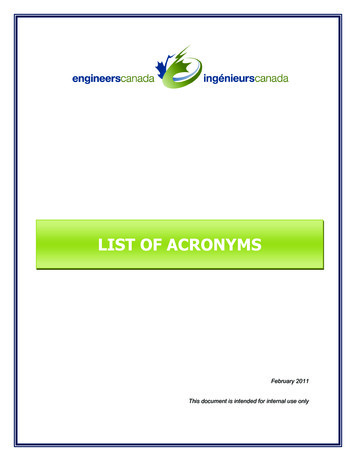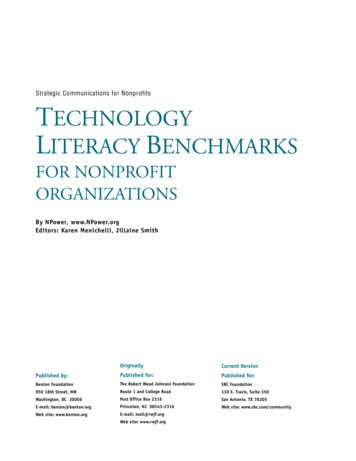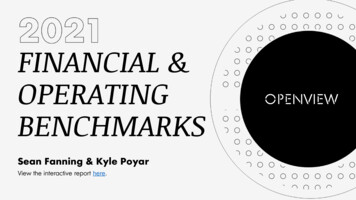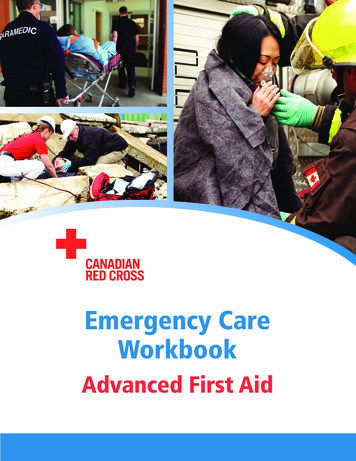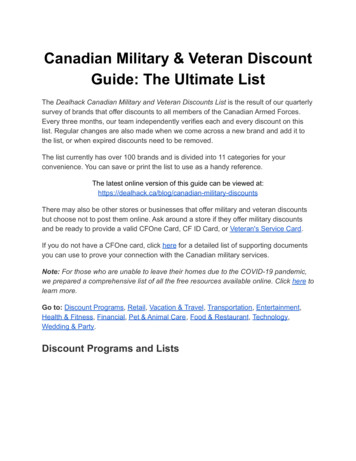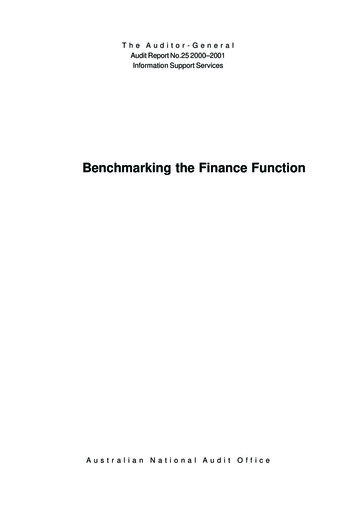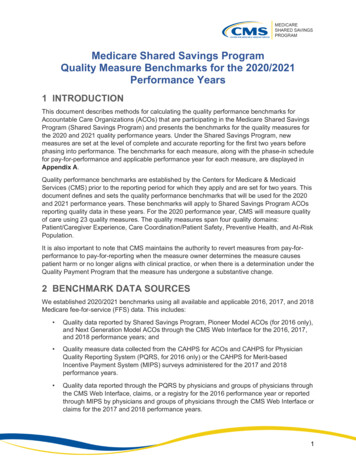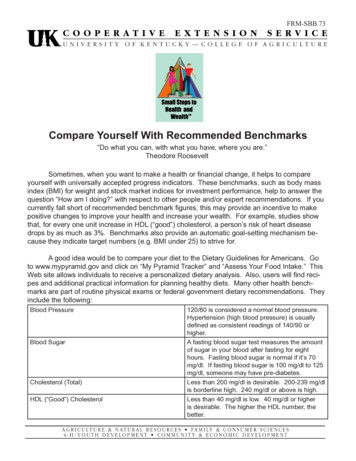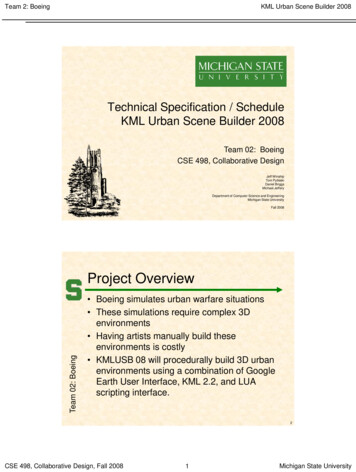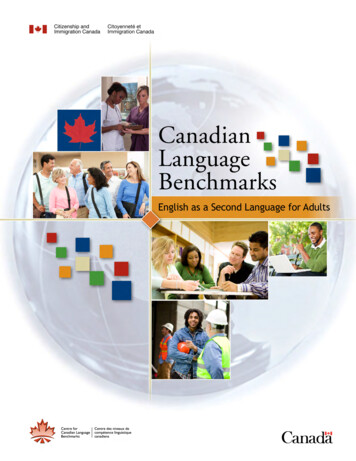
Transcription
CanadianLanguageBenchmarksEnglish as a Second Language for Adults
October 2012 EditionFor information on the Canadian Language Benchmarks or Niveaux de compétence linguistique canadiens visit: www.language.caCentre for Canadian Language Benchmarks294 Albert Street, Suite 400Ottawa, ON K1P 6E6 Her Majesty the Queen in Right of Canada, represented by the Minister of Citizenship and Immigration, 2012Ci63-26/2012ISSN 978-1-100-20772-8C&I-1704-A
October 2012 Edition
Table of ContentsPreface . IAcknowledgements . IIIIntroduction.VStage I Listening . 1Stage II Listening . 13Stage III Listening . 25Stage I Speaking . 37Stage II Speaking . 49Stage III Speaking . 61Stage I Reading . 73Stage II Reading . 85Stage III Reading . 97Stage I Writing . 109Stage II Writing . 121Stage III Writing . 133Competency Tables . 145Glossary . 205Canadian Language Benchmarks
PrefaceThis Canadian Language Benchmarks (CLB) document represents a Canadian language standard established andreinforced through sustained research, application and consultation. The following history summarizes the work thathas been done over a 20-year period to bring this latest version of the standard to publication.The History of the Canadian Language BenchmarksIn 1992, the Government of Canada introduced a language policy to address the needs of adult immigrants. As a firststep, the ministry now called Citizenship and Immigration Canada (CIC) funded a project to investigate the need forCanadian language standards. CIC held extensive consultations across Canada with field experts, instructors of Englishas a Second Language (ESL)1 and English as a Foreign Language (EFL), language program administrators and learners,immigrant-serving agencies, and government representatives. The consultations confirmed the need for a nationallyrecognized set of language standards.Canadian Language Benchmarks, Working Document (1996)As a result of the consultations, CIC established the National Working Group on Language Benchmarks (NWGLB) inMarch 1993. The task of the NWGLB was to guide the development of a set of benchmarks to describe languagedevelopment in the Canadian context. In 1996, CIC published the Canadian Language Benchmarks: English as a SecondLanguage for Adults (Working Document).Centre for Canadian Language Benchmarks (CCLB)Soon after the introduction of the CLB in 1996, the need emerged for an institution outside government to takeresponsibility for CLB projects. Key federal and provincial funders and other stakeholders cooperated to establish theCentre for Canadian Language Benchmarks (CCLB) and, in September 1997, the Board of Directors held its inauguralmeeting. In March 1998, the CCLB received its Charter as a non-profit corporation, and its doors officially opened inOttawa in June.Canadian Language Benchmarks (2000)When CIC introduced the CLB Working Document in 1996, the ministry made a commitment to revisit the document ona regular basis to ensure its ongoing integrity, relevance, and accessibility. Beginning in 1999, the CCLB undertook anational consultation with users of the CLB Working Document. The CCLB commissioned the principal writer of the 1996Working Document to make revisions, which CIC published as the Canadian Language Benchmarks 2000: ESL for Adults.2Niveaux de compétence linguistique canadiens (2006)In 2002, the CCLB Board of Directors agreed to take responsibility for the French version of the CLB, which had beenfunded by CIC and was meant to inform the needs of French as a Second Language (FSL) training programs forimmigrants. The first version, Standards linguistiques canadiens 2002, was sent out to stakeholders and then revised in2005–2006. The second version, Niveaux de compétence linguistique canadiens 2006 : Français langue seconde pouradultes (NCLC), was released in 2006.National Consultation (2008–2010)In 2008, with funding support from the federal and some provincial governments, the CCLB embarked on a nationalconsultation to determine how the CLB and NCLC should evolve to meet the changing needs of stakeholders. More than1,300 people, representing multiple stakeholders, participated in the process. The findings of the consultation allowedthe CCLB to plan for revisions and future directions.Following this consultation, a preliminary analysis was summarized in a discussion paper, which formed the basis for anational forum of 40 individuals representing a broad range of stakeholders. Along with the CCLB Board of Directors,these individuals engaged in further analysis and validation of the findings of the consultations. Among the results ofthe analysis was a list of recommended changes.12In some parts of Canada, ESL may be replaced by English as an Additional Language (EAL).The Canadian Language Benchmarks 2000: ESL for Literacy Learners was also introduced.Canadian Language Benchmarks - I
Canadian Language Benchmarks (2010)A small working group met in December 2009 to discuss stakeholder recommendations and to determine a methodologyand priorities for revisions to the CLB 2000. Soon after, a small team of writers and expert advisors was assembled toimplement the revisions, which were based on the following broad goals: Improving the layout and presentation of information to make the document more user-friendly and accessible.Revising, refining and supplementing information to improve comprehensibility, clarity, consistency andrelevance, as well as reducing redundancy.Maintaining the integrity of the three stages of the CLB (basic, intermediate and advanced), the 12 levels (toensure the CLB reflect the full range of communicative competence) and the theoretical bases of the CLB.Using plain language throughout the document to facilitate the use of the CLB with a broad range of users.Including information critical for a common understanding of the CLB among the majority of users.The resulting draft document was reviewed by 10 external experts and three members of an advisory committeeformed by the CCLB. Their feedback was incorporated into the working document.ValidationIn early 2011, the CCLB undertook the first steps of the validation 3 by developing a common theoretical framework forthe CLB and NCLC (Phase I). This document draws upon widely accepted research in the field of language education,including key principles applicable to all languages and contributions from the ESL and FSL fields. The theoreticalframework underwent extensive independent review at each stage of its development. It was later compared with theCommon European Framework of Reference (CEFR), the American Council for the Teaching of Foreign Languages(ACTFL) guidelines, and the Échelle québécoise. These comparisons showed that the theoretical framework wasconsistent not only with the theoretical concepts it articulated, but also with the key principles underlying otherlanguage frameworks.The CLB and NCLC were then validated against the theoretical framework to determine whether they accuratelyreflected the underlying theory (Phase II). Six independent experts mapped each descriptor in the standards documentsonto the theoretical framework to identify gaps where components of the theoretical models that served as afoundation for the documents were not adequately represented. The documents were further fine-tuned and both havebeen accepted as accurate reflections of the theoretical framework and consistent with widely accepted research.The next step in the process was an extensive field validation by the documents’ end users (Phase III). A keycomponent of this step was the development of exemplars to test the validity, clarity, and reliability of descriptors.Content experts developed Reading and Listening texts and tasks for the 12 levels, as well as prompts which were usedto collect exemplars of learner performance in Speaking and Writing. The tasks and exemplars were independentlybenchmarked by six experts, with inter-rater agreement confirming the validity and reliability of the descriptors. Then,along with the revised CLB and NCLC, they were field tested with more than 100 practitioners across Canada. Thesepractitioners fulfilled two key roles: first, they confirmed the level of the exemplars based on their experience withlearners at specific levels, and second, they provided feedback on the clarity, completeness, and accuracy of therepresentation of these levels. This step informed the final fine-tuning of the standards.In early 2012, the validation project leads and two independent validation experts confirmed that the revised andvalidated CLB and NCLC conform to the basic applicable standards for reliability and validity set out in the Standardsfor Educational and Psychological Testing,4 and that the validation process supports the use of CLB and NCLC asnational standards of English and French for living, working and studying in Canada and as valid, reliable standards foruse for a variety of purposes, including high-stakes ones, and in a variety of contexts, including community, workplaceand study settings.3A detailed validation report is available at www.language.ca.4American Educational Research Association. (1999). Standards for educational and psychological testing. Washington, DC:American Psychological Association.II - Canadian Language Benchmarks
AcknowledgementsCanadian Language Benchmarks: English as a Second Language for AdultsThe Centre for Canadian Language Benchmarks (CCLB) would like to thank all of the funders who contributed to therenewal/revision of the CLB standard. The process, from the national consultation to the validation, was funded byCitizenship and Immigration Canada, National Headquarters; Citizenship and Immigration Canada, Ontario Region; andthe governments of Alberta, British Columbia, Manitoba, Ontario and Saskatchewan.The CCLB would also like to thank the 1,300 participants in the 2008–2010 National Consultation on the CLB2000/NCLC 2006 who provided the information for this version of the Canadian Language Benchmarks and for therevised version of the Niveaux de compétence linguistique canadiens.Also, the CCLB would like to acknowledge the valuable contribution of experts across Canada who developed themethodology to engineer changes to the CLB 2000 at the December 2009 working group meeting in Ottawa. The groupconsisted of Carol Derby, Anne Hajer, Karen Hammond, Linda Johansson, Joanne Pettis, Christina Stechishin, and GailStewart.Revision TeamProject Lead: Anne HajerRevisers/Writers: Anne Hajer, Anne-Marie KaskensExpert Advisors: Gail Stewart, Andrea StrachanContributing Writers: Peggy Irwin, Joanne Pettis, Anne Senior, Gail StewartPan-Canadian Expert Reviewers: Denise DeLong, Lucy Epp, Tara Holmes, Dr. Amelia K. Hope, Thomas Jiry,Marianne Kayed, Bernice Klassen, John Kostoff, Marisa Mazzulla, Jennifer McKay, Ellen Pilon, Anne Senior,Monica Waterhouse, Elizabeth WestCLB National Advisory Committee members: Anna DeLuca, Dr. Sheila Nicholas, June ShymkoProject Manager: Carmen ChamanValidation Team (Phase I and Phase II)Project Leads: Dr. Ross Barbour, Dr. Monique Bournot-TritesContributing Researcher/Writer: Dr. Monika JezakIndependent Experts: Dr. Natalia Dankova, Dr. Albert Dudley, Cheryl Howrigan, Dr. Enrica Piccardo,Dr. Shahrzad Saif, Dr. Antonella ValeoProject Manager and Contributing Researcher/Writer: Daphné Blouin CarbonneauValidation Team (Phase III)Project Lead: Dr. Nicholas ElsonCLB Expert Validation Panel: Lorene Anderson, Judith Bond, Wendy Ilott, Adriana Ionescu-Parau,Dr. Seonaigh MacPherson, Lisa PetitIndependent Validation Experts: Dr. Philip Nagy, Dr. David WattProject Manager: Daphné Blouin CarbonneauCanadian Language Benchmarks - III
Acknowledgements for the CLB 2000 and CLB 1996Canadian Language Benchmarks (2000)Writer: Grazyna Pawlikowska-SmithAdvisory Committee: Dr. Tracy Derwing, Dr. Elizabeth Gatbonton, Ann Gray-Elton, Marian RossiterCanadian Language Benchmarks, Working Document (1996)Writers of the Primary Draft of CLB: Elizabeth Ackermann and Cathryn ColpRevisions to the Draft: Grazyna Pawlikowska-WalentynowiczNational Working Group on Language Benchmarks: Jamie Baird, Joan Baril, Bita Bateni, Elza Bruk,Raminder Dosanjih, Catarina Garcia, Maureen Gross, Artur Gudowski, Sutrisna Iswandi, Mary Keane, Grant Lovelock,Lynne McBeath, Pat Parnall, D’Arcy Phillips, Eleanor Rogers, Peggie Shek, Elizabeth Taborek, Martha Trahey,Shailja VermaIV - Canadian Language Benchmarks
IntroductionThe Canadian Language Benchmarks: General DescriptionThe Canadian Language Benchmarks (CLB) standard is a descriptive scale of language ability in English as a SecondLanguage (ESL) written as 12 benchmarks or reference points along a continuum from basic to advanced. The CLBstandard reflects the progression of the knowledge and skills that underlie basic, intermediate and advanced abilityamong adult ESL learners.The Canadian Language Benchmarks are: a set of descriptive statements about successive levels on the continuum of language ability,a description of communicative competencies and performance tasks through which learners demonstrateapplication of language knowledge (i.e., competence) and skill (i.e., ability),a national standard for planning curricula for language instruction in a variety of contexts,a framework of reference for learning, teaching, programming and assessing adult ESL in Canada.The Canadian Language Benchmarks are NOT: a description of the discrete elements of knowledge and skills that underlie communicative competence (suchas specific grammatical structures, elements of pronunciation, vocabulary items, micro-functions, culturalconventions),a curriculum,5tied to any specific instructional method,6an assessment.Intended Audience and PurposeThe intended audience for the CLB is the professional field of adult ESL instructors, assessors, curriculum and resourcedevelopers, test designers and academics. The CLB standard can also be used to inform funders of English languagetraining programs, labour market associations, licensing bodies, and employers.The CLB fulfill several key purposes for learners, educators and assessors, as well as for the broader community.For LearnersThe CLB provide a basis for learners to plan their language learning, set or adjust goals, and monitor progress. As thenational standard for describing communicative language ability, the CLB can facilitate a common understanding oflearner credentials that allows a smooth transition between classes, programs and institutions, as well as recognitionby professional organizations and licensing bodies across Canada.For Educators, Assessors and Test Developers Working with Adult ESL LearnersThe CLB standard provides a professional foundation of shared philosophical and theoretical views on language abilitythat informs language instruction and assessment. It provides a common national framework for describing andmeasuring the communicative ability of ESL learners for instructional and other purposes, ensuring a common basis forthe development of programs, curricula, resources and assessment tools that can be shared across Canada.The CLB help the professional field to articulate ESL needs, best practices and accomplishments.5The CLB do not describe or follow any specific curriculum or syllabus.Although no instructional method is specified in the implementation of the CLB, instructional practices should focus on preparinglearners to carry out contextualized ‘real world’ communicative tasks consistent with the CLB.6Canadian Language Benchmarks - V
For the Broader CommunityThe CLB contribute to clear, informed communication between the ESL community and other stakeholders andorganizations (such as instructors in related fields, applied college programs, TESL and other educational programs,counselors and language education funding bodies). The CLB also provide information for labour market associations,sector councils, licensing bodies and employers who seek to understand how language requirements for professions andtrades should be referenced to the standard.Theoretical Foundations of the CLBThe CLB are founded on significant theoretical considerations and principles. The most influential one is the principleof communicative language ability, which relates to the ability to understand and communicate messages effectivelyand appropriately in a particular social situation. It is understood that language ability requires an integration oflanguage knowledge, skills and strategies. Many experts have attempted to understand and articulate descriptions oflanguage ability. The CLB standard is based on an adaptation of the model described by Bachman (1990) and the modeldescribed by Bachman and Palmer (1996, 2010). It also draws upon a pedagogical model of communicative competenceby Celce-Murcia, Dörnyei and Thurrell (1995). Language ability is language use or performance. It is the ability tocommunicate: to interact, to express, to interpret and to negotiate meaning, and to create discourse in a variety ofsocial contexts and situations.The CLB model comprises five distinctive components organized under two areas, which together express“communicative language ability.” (Please refer to the graphic on page VIII.)This model suggests that strategic competence may extend beyond purely linguistic considerations and explains howcommunication occurs even in the absence of language. The CLB model takes into account that every act ofcommunication encompasses elements of both organizational and pragmatic competence, guided by decision makingrelated to strategic competence.CLB competency statements reflect the inter-relationship of constituent aspects of language ability that can bedemonstrated through language tasks. This is described in greater detail in the Theoretical Framework for theCanadian Language Benchmarks and Niveaux de compétence linguistique canadiens.7The Role of Grammar and PronunciationGrammar and pronunciation are components of language ability and, as such, may require explicit instruction.However, the purpose of a standards document such as the CLB is not to prescribe discrete pronunciation items andgrammatical forms to be mastered at each benchmark. Rather, the elements of grammatical knowledge that learnersneed to master are determined by the specific requirements of individual real-life tasks and the social context in whichthe tasks are performed.7This document is available at www.language.ca.VI - Canadian Language Benchmarks
The Model of Communicative Language Ability in the CLBGrammatical KnowledgeGrammatical knowledge is needed to construct accurate sentences or utterances and includes knowledge ofvocabulary, syntax, phonology and graphology.Textual KnowledgeTextual knowledge is separated into two components: knowledge of cohesion and knowledge of rhetorical orconversational organization. Knowledge of cohesion is used in producing or comprehending the explicitly markedrelationships between sentences in written texts or between utterances in conversations. These include connectingwords, pro-forms (words that can replace different elements in a sentence), ellipsis, synonyms and paraphrases. Inwritten texts, rhetorical organization refers to conventions for sequencing units of information. In conversation, itrefers to the way interlocutors manage the conversation by, for example, taking turns.Functional KnowledgeFunctional knowledge helps language users to map sentences, utterances or text onto underlying intentionsand vice versa. Functional knowledge includes knowledge of ideational, manipulative, heuristic andimaginative functions.Sociolinguistic KnowledgeSociolinguistic knowledge governs how the setting affects actual language use. Factors influencing these variations inlanguage include participants in the exchange, situation, place, purpose of transaction and social situation.Sociolinguistic knowledge includes knowledge of genre, dialects/varieties, registers, natural or idiomatic expressions,cultural references and figures of speech.Strategic CompetenceStrategic competence provides a management function in language use, as well as in other cognitive activities, and canbe viewed as a set of metacognitive strategies comprising goal setting (deciding what one is going to do), appraising(taking stock of what is needed, what one has to work with, and how well one has done) and planning (deciding how touse what one has).Canadian Language Benchmarks - VII
The Model of Communicative Language Ability in the CLBOrganizational KnowledgeLanguage KnowledgeGrammatical KnowledgeStrategic CompetenceThe knowledge of grammar and vocabulary at the sentencelevel, which enables the building and recognition of wellformed, grammatically accurate utterances, according tothe rules of syntax, semantics, morphology andphonology/graphology.The ability to manage the integrationand application of all othercomponents of language ability to thespecific context and situation oflanguage use. It involves planning andassessing communication, avoiding orrepairing difficulties in communication,coping with communication breakdownand using affective devices. Most ofall, its function is to ensureeffectiveness of communication.Textual KnowledgeThe knowledge and application of cohesion and coherencerules and devices in building larger texts or discourse. Itenables the connection of utterances and sentences intocohesive, logical and functionally coherent texts and/ordiscourse.Functional KnowledgePragmatic KnowledgeStrategic CompetenceThe ability to convey and interpret the communicativeintent (or function) behind a sentence, utterance or text. Itencompasses macro-functions of language use (e.g.,transmission of information, social interaction and gettingthings done/persuading others, learning and thinking,creation and enjoyment), and micro-functions, or speechacts (e.g., requests, threats, warnings, pleas), and theconventions of use.Sociolinguistic KnowledgeThe ability to produce and understand utterancesappropriately. It encompasses rules of politeness; sensitivityto register, dialect or variety; norms of stylisticappropriateness; sensitivity to "naturalness"; knowledge ofidioms and figurative language; knowledge of culture,customs and institutions; knowledge of cultural references;and uses of language through interactional skills to establishand maintain social relationships.VIII - Canadian Language Benchmarks
Guiding PrinciplesThe following fundamental principles are inherent in the standard and, consequently, inform instructional andassessment decisions.The CLB are Competency-BasedCompetency Statements stress what the learner can do in English. Competencies may be understood as thedemonstrable application of knowledge and skills by individual learners. The CLB Competency Statements do notspecify context. For example, a Competency Statement might say that a person can fill in simple forms withoutspecifying the particular type of form. This is because the type of form would depend on the individual’s situation,needs and goals. For example, some ESL learners might need to fill out forms to apply for services within thecommunity, while others might need to complete job-related service request forms or apply for admission to academicprograms. Given the range of possible situations and contexts, the sample tasks in this document have been selected torepresent a range of needs, interests and contexts within community, work and study settings.The CLB relate language to the contexts in which it is used and the communicative functions it performs. For example,individuals may use English to initiate and maintain relationships, express hopes, dreams and feelings, transactbusiness, plan, persuade, inform or instruct.8The CLB are Learner-CentredCompetencies should be embedded in tasks and contexts that are purposeful, relevant and meaningful to the learner,and tailored to an individual’s abilities and learning style. Sample Tasks are provided in the document to illustrateeach competency in a real-life context; it is assumed that in instructional settings, CLB competencies will becontextualized in tasks that are relevant to the needs and specific interests of learners.The CLB are Task-BasedThe notion of the language task—a communicative “real world” instance of language use to accomplish a specificpurpose in a particular context—is central to the CLB. When instructors or assessors describe communicative languageability, they are describing a person’s ability to accomplish communicative language tasks for particular contexts.Accomplishing communicative tasks provides the learner, instructor or assessor with demonstrable and measurableperformance outcomes.The CLB Stress Community, Study9 and Work-Related TasksLanguage is used in specific social contexts with particular individuals. The situation and the relationship of theindividuals communicating in those social contexts may require the use of different cultural (pragmatic) conventions. Inaddition, specific background information and prior knowledge may also be necessary to carry out particular tasks inspecific social contexts. Language instruction and assessment practices need to reflect contexts that are relevant andmeaningful to learners within community, work and study settings.8The CLB document does not include all possible competencies and functions associated with language use. As a descriptivedocument, it presents a selection of representative Competency Statements and indicators that suggest the kinds of things thatlearners can typically do and the degree of ability they generally demonstrate at each successive benchmark.9The term “study” is used throughout the document to include academic and other educational contexts.Canadian Language Benchmarks - IX
Overview of the CLB StandardA Canadian Language Benchmark is a description of a person’s ability in a specific language skill.Each benchmark describes: Characteristics of Speaking, Listening, Reading or Writing ability as listed in the Profile of Ability.What a person can do in each language skill, as presented in the Competency Statements.Specific conditions under which abilities can be demonstrated (including factors such as time constraints,length of task/text, assistance given), as listed in the Profile of Ability.Examples of possible communication tasks for community, study and work contexts, as illustrated in theSample Tasks.Indicators of task success, as listed in the Sample Indicators of Ability found below the CompetencyStatements.Benchmark StagesThe 12 benchmarks are organized into three stages, numbered I, II and III. Each stage is associated with a degree ofcomplexity and demand. Within each stage, there are four benchmarks that progress from initial to fluent ability.10This progression indicates a learner's progression across a stage, as reflected in the Profiles of Ability that appear on asingle page for each stage.The three stages are:Stage I – Basic Language Ability (Benchmarks 1–4)Basic language ability encompasses abilities that are required to communicate in common and predictable contextsabout basic needs, common everyday activities and familiar topics of immediate personal relevance. In the CLB, theseare referred to as non-demanding contexts of language use.Stage II – Intermediate Language Ability (Benchmarks 5–8)Intermediate language ability encompasses abilities that allow fuller participation in a wider variety of contexts. It isthe range of abilities required to function independently in most familiar situations of daily social, educational andwork-related life experience, and in some less predictable contexts. In the CLB, these are referred to as moderatelydemanding contexts of language use.Stage III – Advanced Language Ability (Benchmarks 9–12)Advanced language ability encompasses abilities required to communicate effectively, appropriately, accurately andfluently about most topics in a wide range of contexts and situations, from predictable to unfamiliar, from general toprofessionally complex and from specific to nuanced, in communicatively demanding contexts. Learners at this stagehave a sense of purpose and audience when communicating (including distance, politeness and formality factors,appropriate register and style, suitable volume or length of communication, accuracy and coherence of discourse,vocabulary range and precision). At this stage, communicating can involve using language within high-stakes or highrisk social, academic and work-related contexts, and in situations in which features of the communication (such asdiplomacy, tact, precision) can have significant consequences. In the CLB, these are referred to as demanding contextsof language use.NoteMany ESL learners are at different benchmarks in the four language skills, and a learner's separate benchmarks areoften in different
Canadian Language Benchmarks: English as a Second Language for Adults (Working Document). Centre for Canadian Language Benchmarks (CCLB) Soon after the introduction of the CLB in 1996, the need emerged for an institution outside government to take responsibility for CLB projects. Key federal and provincial funders and other stakeholders .
